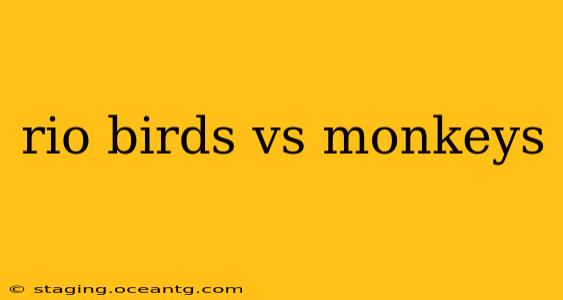The vibrant rainforests of Rio de Janeiro are home to a dazzling array of wildlife, from the brightly colored birds to the agile monkeys. While they coexist in the same ecosystem, the notion of a direct "Rio birds vs. monkeys" conflict is a simplification. Their interactions are more nuanced than a straightforward battle, involving competition for resources, symbiotic relationships, and occasional opportunistic encounters. This article delves into the fascinating dynamics between these two groups of animals.
What Birds Live in Rio?
Rio's avian diversity is remarkable. From the iconic blue-and-yellow macaw, a symbol of Brazilian biodiversity, to the smaller, more elusive species inhabiting the undergrowth, the variety is astounding. Common species include various tanagers, hummingbirds, toucans, and numerous other bird families thriving in the diverse habitats of the region. Their survival depends on a complex interplay of factors, including food availability, nesting sites, and predator avoidance.
What Monkeys Live in Rio?
The monkey population in and around Rio de Janeiro is predominantly comprised of the common marmoset ( Callithrix jacchus) and, less frequently, the black-capped capuchin (Sapajus nigritus). These primates are highly adaptable, occupying various niches within the rainforest and even venturing into urban areas. Their diets consist primarily of insects, fruits, nectar, and other small prey, placing them in potential competition with some bird species.
Do Rio Birds and Monkeys Compete for Resources?
Yes, there is a degree of competition. Both birds and monkeys are largely frugivores (fruit-eaters), so competition for ripe fruit and nectar can certainly occur, especially when resources are scarce. However, it's not a constant, all-out war. The monkeys' larger size and greater strength may allow them to dominate access to certain fruit sources at times, but birds often exploit different feeding strategies and niche habitats to minimize direct conflict. For example, birds might focus on smaller, less accessible fruits, or feed on insects that are not part of the monkey's diet.
What do monkeys eat in Rio?
Monkeys in Rio's rainforests are omnivores, enjoying a varied diet. Fruits are a cornerstone, but they also consume leaves, flowers, insects, small vertebrates, and even tree sap. This dietary diversity helps reduce direct competition with birds.
What do birds eat in Rio?
The Rio bird diet is equally diverse. While many are frugivores, others are insectivores, nectarivores, or even carnivores, targeting small reptiles or amphibians. This broad range of food sources minimizes direct competition with monkeys for particular resources.
Are Monkeys Predators of Birds?
While monkeys are not typically considered avian predators in the traditional sense of actively hunting birds, opportunistic predation can happen. Smaller, less agile birds might occasionally fall prey to larger monkeys, particularly young or injured individuals. However, this is not a defining aspect of their ecological interaction.
Do Birds and Monkeys Have Symbiotic Relationships?
Indirect symbiotic relationships can exist. For example, birds might benefit from the monkeys' foraging activities, as monkeys dislodge insects or uncover fruit that the birds can then exploit. However, these are not tightly defined, mutually beneficial relationships like those seen in some other ecosystems.
Conclusion: A Complex Ecosystem
The relationship between birds and monkeys in the Rio rainforest is far more complex than a simple "vs." scenario implies. Competition for resources occurs, but it's not a constant struggle. The diversity of food sources and foraging strategies employed by both groups reduces direct conflict. While opportunistic predation might occur, it's not a significant factor in shaping their ecological interaction. Ultimately, both groups contribute to the rich biodiversity and dynamic ecosystem of Rio's rainforest.
